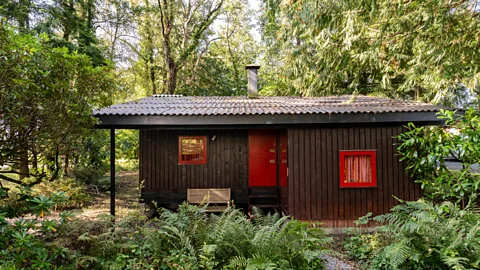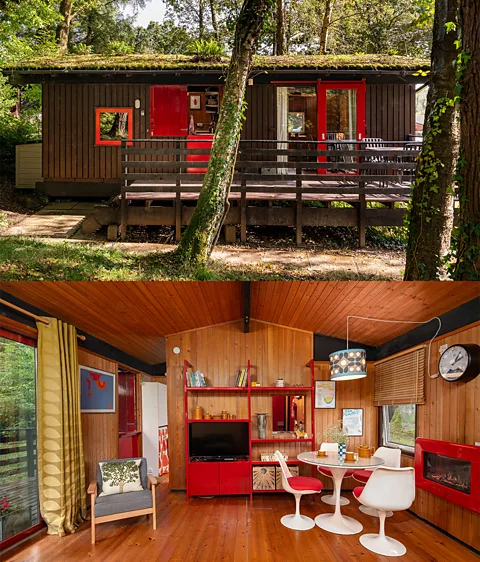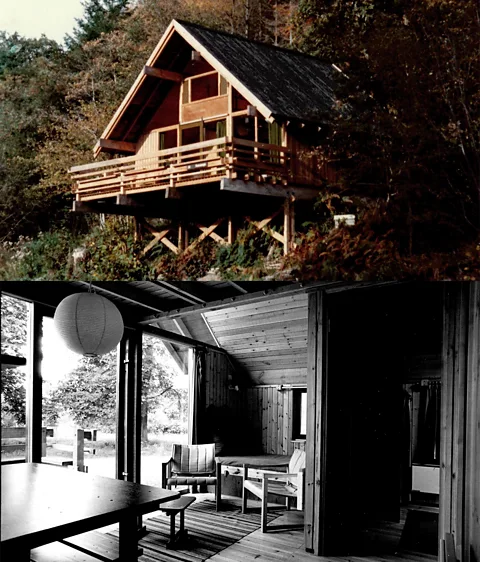
 Vince Jones
Vince JonesIn pockets of the British countryside, it’s possible to stumble across clusters of beautifully designed, Scandi-style cabins. These aren’t a product of the latest trend for off-grid retreats, but were created half a century ago by a pair of Welsh architects, Hird & Brooks. How did they become gripped by crafting the perfect holiday home? And why were they so inspired by Denmark?
By the 1970s, John Hird and Graham Brooks had already won a slew of major awards for their sleek, modernist post-war villas across the Vale of Glamorgan in Wales. But the highpoint of their careers was the prefabricated timber cabins they designed in the 1970s and 1980s for holiday parks in Wales and Forestry Commission sites in Scotland, and the English counties of Cornwall and Yorkshire.
For Brooks, the cabins were an opportunity to distil his design ethos into its clearest, purest, most compact form, says Peter Halliday, co-author with Bethan Dalton of Cabin Crew: Hird & Brooks and the Pursuit of the Perfect Holiday House. “He could do away with the tiresome necessities of domesticity that have to be accommodated in a conventional house, and focus on what really matters.”
 Ian Brooks Collection
Ian Brooks CollectionProfessor Richard Weston, an architect and former Chair of Architecture at Cardiff University, echoes this. “[Brooks] always said the holiday cabins were the highlight of his career,” he writes in the book. “They are a distillation of everything Graham stood for – the love of wood, the appreciation of proper architecture, the orientation of the Sun, and the feel for detailing and space – all stripped down for essential living.”
Hird & Brooks were part of a worldwide boom in simple holiday homes. Many Danes and Swedes already spent their leisure time in cabins, or sommerhuse, along the coast or in forests. In 1960, Denmark had around 50,000 summerhouses. By 1975, the number had trebled, according to Cabin Crew.
Meanwhile, the summer cottage (a close relation of the dacha) was becoming a staple of Soviet society in the Baltic states and much of Central Europe. Everyone, it seems, was at it, even the big-name architects. Le Corbusier, the grand master of modernism, created his Cabanon de Vacances in Roquebrune-Cap-Martin in the south of France in the early 1950s. And in the US, architect Paul Rudolph was behind a series of simple wooden structures on the Florida Keys.
The mushrooming of cabins in the UK was in part a result of increased car ownership from the 1930s, as well as the Holidays with Pay Act of 1938, explains Cabin Crew. The latter led to the construction of mass-scale seaside holiday camps equipped with prefab accommodation.
Getting back to nature
Hird & Brooks’ cabins – some to be bought, others to be rented – drew on the duo’s many study trips to Denmark, because Brooks was Denmark mad. “His heroes were Danish architects, his reference points were the Danish architectural press, and his new wife helped him to embed a Danish design aesthetic into their everyday lives,” the book explains.
“It was all about simple, intelligent design, woodland settings, and a close affinity with nature,” Halliday tells the BBC. “The entire Hird & Brooks team became fascinated, and were eager to apply the same principles here in the UK.”
 Vince Jones
Vince JonesThe firm completed their first holiday homes, for Bierwood near Tenby in Pembrokeshire, in the early 1970s. Timber-framed with exposed roof beams, these lodges were clad in pine match-boarding and had corrugated tiled roofs and Sun terraces. Inside, features included built-in beds and a galley kitchen. The colour pallet – a blue-grey stain on the exterior timber facings, and orange-red window frames and doors – was inspired by those Danish study trips.
“The clearest Scandinavian influence is the use of wood – from the big exposed structural beams to the cedar cladding to the built-in furniture to the little details like the wooden door handles and fitted coat hooks,” says Halliday. He also cites the space-saving wetrooms, “which were a complete novelty in the UK, and the wood-burning stoves, which were commonplace in Scandinavia but not available here, so the architects designed their own, and had them manufactured locally”. And for all the Welsh cabins, Brooks looked at the orientation of the Sun before positioning each cabin on its plot, so as to ensure that users could enjoy as much sunshine as possible – even if sunshine wasn’t always abundant in Wales.
Later, the Forestry Commission – a national organisation owning huge swathes of British countryside – brought in Hird & Brooks to design holiday cabins for its sites at Deerpark in Cornwall, Keldy Castle in North Yorkshire, and Taynuilt in Scotland. “For the Forestry Commission cabins, it was all about imparting a sense of adventure,” says Halliday. “That was the intended function, and everything about the design reflects it.”
 Ian Brooks Collection
Ian Brooks CollectionSome were A-frame designs, some were flat-roofed, and others had standard-pitch roofs. There was also some playfulness. Inside, the second bedrooms had a staggered stack of three bunks. “High-level sleeping and play platforms offered views into the forest, and large slatted terraces with integrated benches blurred the distinctions between indoors and outdoors – all of which added to the sense of adventure the Forestry Commission was so keen to impart,” write Cabin Crew’s authors. Soft furnishings stayed with the distinctive red and orange colourways that the firm had introduced in earlier cabins.
By the end of the 1970s, there were at least 35 UK companies manufacturing or promoting kit-built chalets, and more than 350 holiday parks offering them. Meanwhile, on the continent, the Dutch modernist architect Jacob Berend Bakema produced designs for the holiday village chain Center Parcs.
At this time, the British cabin movement was in part a reaction against the “white heat of technology”, a term used by Prime Minister Harold Wilson in the 1960s to promote science. Bruce Peter, Professor of design history at Glasgow School of Art, expands on this in the book’s introduction. “A growing environmental consciousness emerged, at least among the more politically progressive and culturally engaged. This manifested itself in growing interests in wholefoods, alternative medicine and natural living.”
The simple life
And for Peter, with the benefit of half-a-century’s hindsight, Hird & Brooks’ holiday cabins “appear very successfully to have withstood the test of time. Back in the 1970s, environmentalism was mostly considered to be a fringe concern, but, in recent decades, it has moved into the mainstream. The cabins’ construction – using mostly natural materials in an era when synthetics were all the rage – now appears to have been highly prescient. And, with reasonable maintenance, their timber external finishes have tended to weather well.” What’s more, he writes, the type of outdoor-centred holiday-making for which the cabins were intended has also proven enduringly popular, at least among particular demographics.
A few factors coming together means that there is now a renewed interest in the cabins, Dalton tells the BBC. First, she cites the popularity of mid-century architecture and interior design, “especially among those of us who grew up in the 1970s and 1980s. It evokes a nostalgic charm, reminding us of the spaces and styles we fondly remember from childhood.”
Then there’s the “tiny house” movement, with cabin life appealing to people seeking a simpler, more minimal way of life, off-grid and immersed in nature. “A cabin holiday offers a taste of that lifestyle without the full-time commitment,” says Dalton. “And, of course, in this digital age, people are always looking for an Instagrammable holiday image, and these cabins certainly have that covered with their striking red-painted windows and doors.”
So perhaps it’s no surprise that some of Brooks’ cabins have endured. And several of them are still in the hands of the original families. “For the most part, the cabins look to be in near-pristine condition,” the authors write. “Clearly, the owners like things the way they are.”


